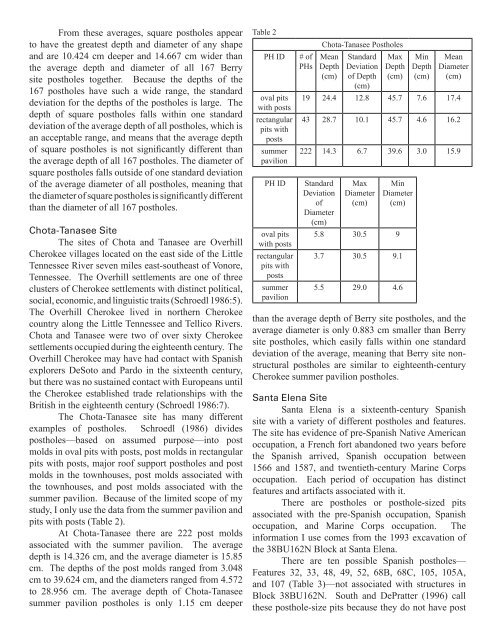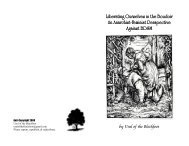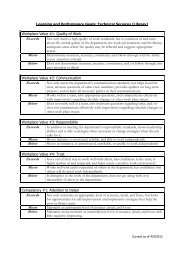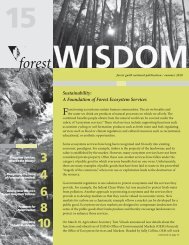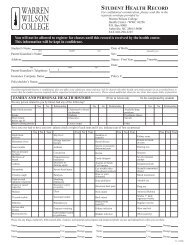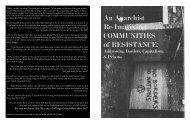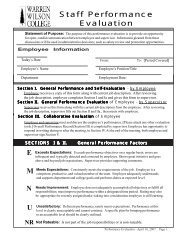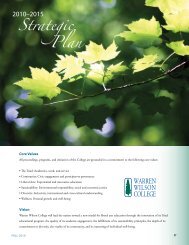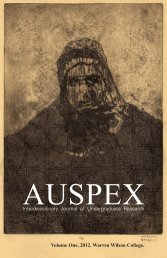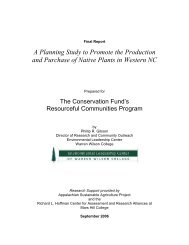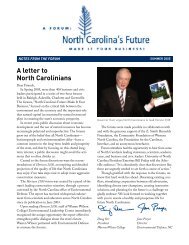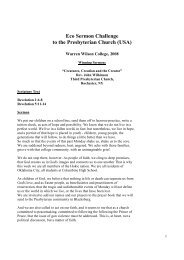Native American and Spanish Ancillary Structures - Warren Wilson ...
Native American and Spanish Ancillary Structures - Warren Wilson ...
Native American and Spanish Ancillary Structures - Warren Wilson ...
Create successful ePaper yourself
Turn your PDF publications into a flip-book with our unique Google optimized e-Paper software.
From these averages, square postholes appear<br />
to have the greatest depth <strong>and</strong> diameter of any shape<br />
<strong>and</strong> are 10.424 cm deeper <strong>and</strong> 14.667 cm wider than<br />
the average depth <strong>and</strong> diameter of all 167 Berry<br />
site postholes together. Because the depths of the<br />
167 postholes have such a wide range, the st<strong>and</strong>ard<br />
deviation for the depths of the postholes is large. The<br />
depth of square postholes falls within one st<strong>and</strong>ard<br />
deviation of the average depth of all postholes, which is<br />
an acceptable range, <strong>and</strong> means that the average depth<br />
of square postholes is not significantly different than<br />
the average depth of all 167 postholes. The diameter of<br />
square postholes falls outside of one st<strong>and</strong>ard deviation<br />
of the average diameter of all postholes, meaning that<br />
the diameter of square postholes is significantly different<br />
than the diameter of all 167 postholes.<br />
Chota-Tanasee Site<br />
The sites of Chota <strong>and</strong> Tanasee are Overhill<br />
Cherokee villages located on the east side of the Little<br />
Tennessee River seven miles east-southeast of Vonore,<br />
Tennessee. The Overhill settlements are one of three<br />
clusters of Cherokee settlements with distinct political,<br />
social, economic, <strong>and</strong> linguistic traits (Schroedl 1986:5).<br />
The Overhill Cherokee lived in northern Cherokee<br />
country along the Little Tennessee <strong>and</strong> Tellico Rivers.<br />
Chota <strong>and</strong> Tanasee were two of over sixty Cherokee<br />
settlements occupied during the eighteenth century. The<br />
Overhill Cherokee may have had contact with <strong>Spanish</strong><br />
explorers DeSoto <strong>and</strong> Pardo in the sixteenth century,<br />
but there was no sustained contact with Europeans until<br />
the Cherokee established trade relationships with the<br />
British in the eighteenth century (Schroedl 1986:7).<br />
The Chota-Tanasee site has many different<br />
examples of postholes. Schroedl (1986) divides<br />
postholes—based on assumed purpose—into post<br />
molds in oval pits with posts, post molds in rectangular<br />
pits with posts, major roof support postholes <strong>and</strong> post<br />
molds in the townhouses, post molds associated with<br />
the townhouses, <strong>and</strong> post molds associated with the<br />
summer pavilion. Because of the limited scope of my<br />
study, I only use the data from the summer pavilion <strong>and</strong><br />
pits with posts (Table 2).<br />
At Chota-Tanasee there are 222 post molds<br />
associated with the summer pavilion. The average<br />
depth is 14.326 cm, <strong>and</strong> the average diameter is 15.85<br />
cm. The depths of the post molds ranged from 3.048<br />
cm to 39.624 cm, <strong>and</strong> the diameters ranged from 4.572<br />
to 28.956 cm. The average depth of Chota-Tanasee<br />
summer pavilion postholes is only 1.15 cm deeper<br />
Table 2<br />
PH ID # of<br />
PHs<br />
oval pits<br />
with posts<br />
rectangular<br />
pits with<br />
posts<br />
summer<br />
pavilion<br />
Chota-Tanasee Postholes<br />
Mean<br />
Depth<br />
(cm)<br />
St<strong>and</strong>ard<br />
Deviation<br />
of Depth<br />
(cm)<br />
Max<br />
Depth<br />
(cm)<br />
Min<br />
Depth<br />
(cm)<br />
Mean<br />
Diameter<br />
(cm)<br />
19 24.4 12.8 45.7 7.6 17.4<br />
43 28.7 10.1 45.7 4.6 16.2<br />
222 14.3 6.7 39.6 3.0 15.9<br />
PH ID St<strong>and</strong>ard<br />
Deviation<br />
of<br />
Diameter<br />
(cm)<br />
oval pits<br />
with posts<br />
rectangular<br />
pits with<br />
posts<br />
summer<br />
pavilion<br />
Max<br />
Diameter<br />
(cm)<br />
Min<br />
Diameter<br />
(cm)<br />
5.8 30.5 9<br />
3.7 30.5 9.1<br />
5.5 29.0 4.6<br />
than the average depth of Berry site postholes, <strong>and</strong> the<br />
average diameter is only 0.883 cm smaller than Berry<br />
site postholes, which easily falls within one st<strong>and</strong>ard<br />
deviation of the average, meaning that Berry site nonstructural<br />
postholes are similar to eighteenth-century<br />
Cherokee summer pavilion postholes.<br />
Santa Elena Site<br />
Santa Elena is a sixteenth-century <strong>Spanish</strong><br />
site with a variety of different postholes <strong>and</strong> features.<br />
The site has evidence of pre-<strong>Spanish</strong> <strong>Native</strong> <strong>American</strong><br />
occupation, a French fort ab<strong>and</strong>oned two years before<br />
the <strong>Spanish</strong> arrived, <strong>Spanish</strong> occupation between<br />
1566 <strong>and</strong> 1587, <strong>and</strong> twentieth-century Marine Corps<br />
occupation. Each period of occupation has distinct<br />
features <strong>and</strong> artifacts associated with it.<br />
There are postholes or posthole-sized pits<br />
associated with the pre-<strong>Spanish</strong> occupation, <strong>Spanish</strong><br />
occupation, <strong>and</strong> Marine Corps occupation. The<br />
information I use comes from the 1993 excavation of<br />
the 38BU162N Block at Santa Elena.<br />
There are ten possible <strong>Spanish</strong> postholes—<br />
Features 32, 33, 48, 49, 52, 68B, 68C, 105, 105A,<br />
<strong>and</strong> 107 (Table 3)—not associated with structures in<br />
Block 38BU162N. South <strong>and</strong> DePratter (1996) call<br />
these posthole-size pits because they do not have post


